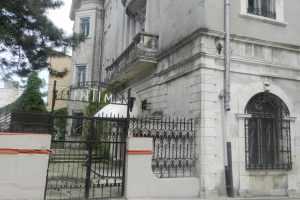

It was designed during 1887 by the Italian sculptor Ettore Ferrari. An identical replica exists since 1925 in Sulmona (Italy).
It is located in the old part of the city, in Ovidiu Square, in front of the first building of Constanţa City Hall, today the National Museum of History and Archaeology, near Tomis port.
The first amongst the statuary monuments erected in Constanţa after reentering under Romanian administration is the one that depicts the great Latin poet Publius Ovidius Naso (43 BCE – 17 C.E.). The bronze statue depicts Ovidiu into a deep meditative attitude. The statue unveiling from August 1887 occasioned a real celebration attended by all people from Constanţa, headed by the prefect Remus Opreanu, the initiator of the “Committee for the statue of Ovidiu.”
The statue stands on a pedestal of white marble, on which is encrusted a plate with a text of “Tristia”.
“Under this stone lies Ovidiu, the singer of gentle loving
succumbed by his talent.
O, you who pass on and if you ever loved
Pray for him to sleep smoothly.”
Originally, the statue was placed facing north, the construction of the City Hall Palace imposing in 1921, moving it on the actual place. During the German-Bulgarian occupation during the years 1916-1918, the statue was taken down from the pedestal by the Bulgarian army, to be taken as plunder of war, but the intervention of certain German officers have stopped the original “cultural initiative”; until the return of the Romanian authorities, during November 1918, the statue was housed in the basement of the City Hall. During 1925, a faithful replica of this work was unveiled in the hometown of the poet – Sulmona.
Ettore Ferrari, born into a family of fine artists, has become one of the protagonists of the artistic rebirth movement after the Italy unification. His father, sculptor Filippo Ferrari (1819-1897), has taught him sculpture and has instilled his passion for Republican politics.
During 1868 he won a scholarship at the Accademia di San Luca from Rome, that he graduated during 1872, then he remained within the academy for a long time as professor and, at the same time, deputy within the Italian parliament.
Between 1904 and 1917 Ettore Ferrari was the Great Master of the Freemasonic Order of the Grand Orient of Italy (Grande Oriente d’Italia). From 1918 until 1929, he was Sovereign Grand Commander of the Scottish Rite from Italy. As a consistent defender of democratic values, Ettore Ferrari was one of the most consistent opponents of Mussolini’s fascism.
After November 1925 when Benito Mussolini passed the law prohibiting the activity of secret societies, Freemasonry has been practically outlawed. Because Ettore Ferrari has not abandoned his beliefs, he was placed under police observation and his workshop was devastated several times by fascists. His repression has culminated during May 1929 with his indictment for the crime of having tried to reorganize Freemasonry. Immediately afterwards, Ettore Ferrari transferred his full powers to Giuseppe Lenti, Lieutenant Grand Commander and significant anti-fascist fighter, who had emigrated to France. After only three months, Ettore Ferrari died in Rome. He was buried in Cimitero Comunale Monumentale Campo Verano from Rome.


